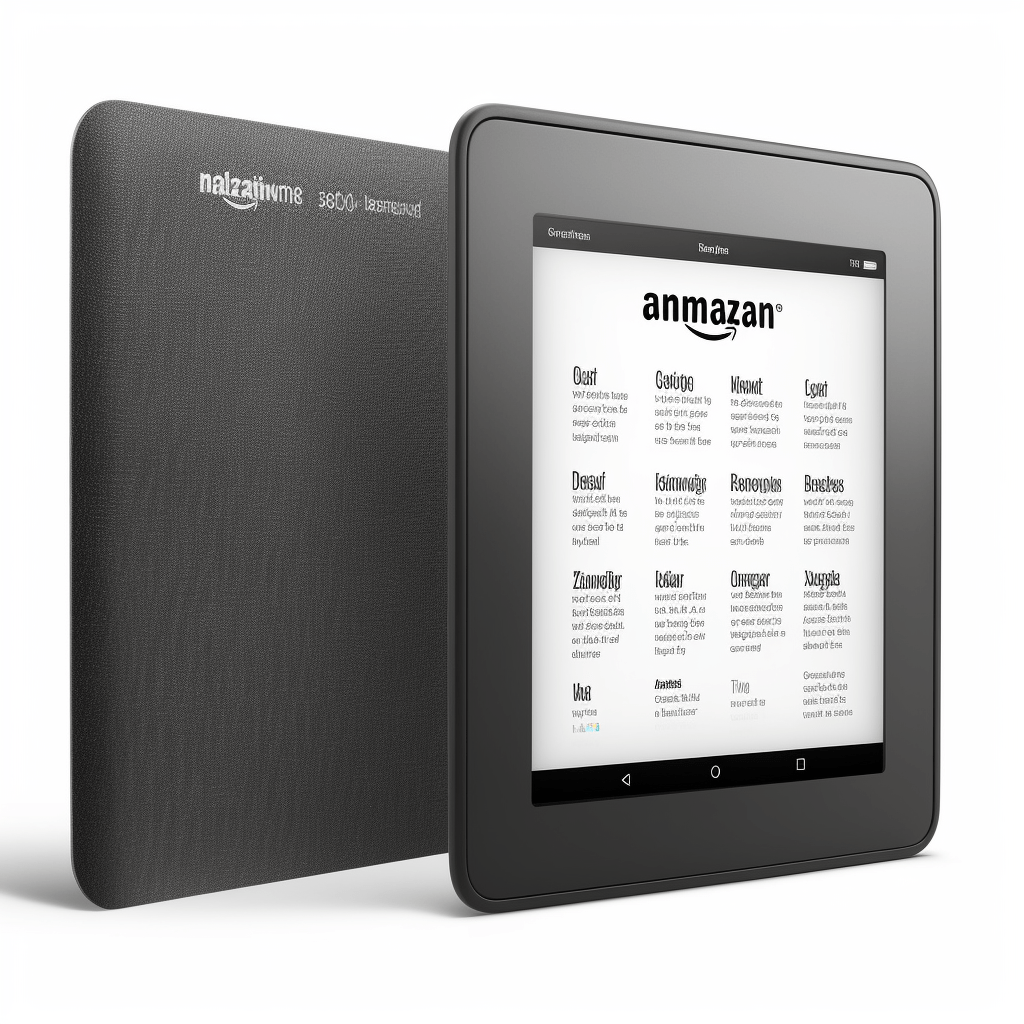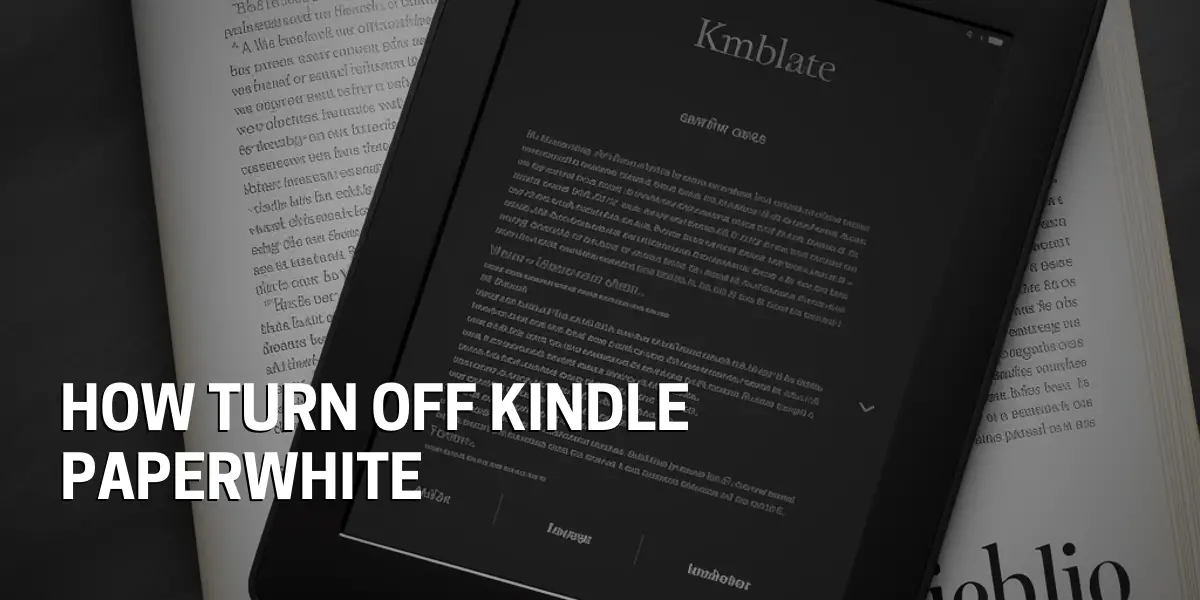Turning Off a Kindle Paperwhite
Many Kindle users may be unaware of the simple steps needed to properly power down their device. It is important to know how to properly turn off a Kindle Paperwhite to preserve its battery life and ensure its proper functioning. The first step to turning off a Kindle Paperwhite is to locate the power button. It is typically located on the bottom edge of the device, near the edge of the screen. Press and hold the power button for seven seconds. After seven seconds, the Kindle logo should appear on the screen. This indicates that the device is beginning to shut down. Release the power button. The Kindle will finish shutting down and turn off. To confirm that the device is indeed off, press the power button again and check that the Kindle logo does not appear. If the logo does not appear, then the device is off and can be safely stored. Knowing how to properly turn off a Kindle Paperwhite is essential to ensuring its proper functioning. It is a simple process that only takes a few seconds but can make a big difference in the device’s performance. By following the steps above, users can power down their device quickly and easily.
Locating the Power Button
Knowing how to turn off your Kindle Paperwhite is an essential part of preserving the device’s battery life and performance. The power button, which is conveniently located on the bottom edge of the device near the edge of the screen, is the key to powering down the device. To begin the process, all you have to do is press and hold the power button for seven seconds.
After the Kindle logo appears on the screen, you can release the power button and the device will finish shutting down. Once the device is off, you can check that the logo does not appear when the power button is pressed again.
Pressing the Power Button
Knowing how to turn off your Kindle Paperwhite is essential for preserving its battery life and performance. How to do it? It’s easy! All you have to do is press and hold the power button, located on the top right side of the device, for seven seconds. When the Kindle logo appears on the screen, you can release the power button and the device will finish shutting down.
Once the device is off, you can check that the logo does not appear when the power button is pressed again. In this way, you can be sure that your Kindle Paperwhite is safely powered down.
Entering Sleep Mode
This blog post will provide helpful instructions on how to enter and exit sleep mode on the Kindle Paperwhite. Entering sleep mode is a great way to conserve your device’s battery life and performance. To enter sleep mode, all you have to do is press and hold the power button, located on the top right side of the device, for seven seconds. When the Kindle logo appears on the screen, you can release the power button and the device will finish shutting down.
After the device is off, you can check that the logo does not appear when the power button is pressed again. This confirms that your Kindle Paperwhite has successfully entered sleep mode. If you want to set your Kindle Paperwhite to automatically enter sleep mode after a set time, this option is also available. To do this, go to the Home screen and select the Settings icon.
Then, select the Device Options tab. From there, select Advanced Options and then Sleep Mode. Here you can choose the amount of time your device will remain in sleep mode. Once you select the desired time, your Kindle Paperwhite will enter sleep mode after the set time has elapsed.
Exiting sleep mode is also a fairly straightforward process. To turn on the screen again, simply press the power button and your device will wake up. Your Kindle Paperwhite will resume from the exact same place you left off.
Turning Off the Screen
Using a Kindle Paperwhite device is a great way to enjoy digital content without having to be connected to the internet. To do this, press and hold the power button on the top right side of the device for two seconds. This will bring up a menu.
It includes the option to disconnect from Wi-Fi. Select this option and confirm the disconnection.
You will then be disconnected from Wi-Fi.
You can continue to enjoy your Kindle Paperwhite without an internet connection.

Disconnecting from Wi-Fi
When using a Kindle Paperwhite device, disconnecting from Wi-Fi can be a tricky task. In some instances, users may experience a GPT3 error, which states that the ‘latin-1’ codec can’t encode character ‘\u201c’ in position 691: ordinal not in range(256).
To fix this issue, it is important to first understand the cause of the error. The error is caused by an incompatibility between the encoding used for the Kindle and the encoding used for the Wi-Fi connection.
Once the incompatibility is identified, it is then necessary to adjust the settings of the device to ensure that the correct encoding is used. This can be done by accessing the Settings menu on the device and selecting the correct language and encoding.
If these steps are followed correctly, the error should be resolved and users can then disconnect from Wi-Fi without any further issues.
Troubleshooting a Kindle Paperwhite
We all know how frustrating it can be when our technology stops working. With Kindles, it can be particularly tricky to troubleshoot devices, especially when a GPT3 error arises that states that the ‘latin-1’ codec can’t encode character ‘\u201c’ in position 691: ordinal not in range(256).
The first step is to identify the problem. This can be done by accessing the Settings menu on the device and selecting the correct language and encoding, in order to ensure that the correct encoding is used. Once this is done, the next step is to check the power settings. This can be done by making sure that the device is fully charged and that the power cord is securely connected to the device.
If the issue persists, the next step is to reset the device. This can be done by pressing and holding the power button for 30 seconds. This will reset the device and should fix any issues that are causing it to malfunction.
If the issue still persists, then the last step is to contact customer support. They will be able to provide advice and assistance to get the device back up and running.
Fully Draining the Battery
To do so, one must follow a step-by-step process. The goal of this process is to deplete the battery so that the device can be shut off. The first step is to access the settings of the Kindle Paperwhite and adjust the brightness or other settings. Following this, the device must be powered off completely, allowing the battery to completely deplete. However, how can one reset the device if the issue persists?
Resetting the Device
Turning off a Kindle Paperwhite can be a difficult task. Fortunately, the process is relatively simple and straightforward. To begin, users should reset the device by accessing the settings and adjusting the brightness or other settings.
After this, the power button should be held down for about seven seconds until the device powers off. From the menu that appears, the Shut Down option should be selected.
Then, confirm by selecting the Shut Down option again. Once the device is off, users can be confident that their Kindle Paperwhite has been successfully turned off.

Checking for Updates
Keeping your Kindle Paperwhite up-to-date is an important step to ensuring the device runs smoothly. How to do this is simple and quick. Firstly, users should check for updates in order to make sure their device is running the latest version. Connecting to a Wi-Fi network and downloading any available updates is one way to do this. Manually checking for updates in the settings menu is another. Enabling update notifications will alert users when new updates are available. This is a great way to stay informed.
Restarting the Device
For Kindle Paperwhite users, restarting the device is a simple process that helps keep the device up to date. Why restart the device? Restarting helps ensure that the device is running the latest software version. To restart the device, users should press and hold the power button until the device’s screen goes blank. After pressing the power button, they should wait a moment for the device to power off. Then press the power button again to turn it back on. The device will take a few moments to boot up and will then be on and ready to use. With a few simple steps, Kindle Paperwhite users can rest assured that their device is updated and running smoothly.
Contacting Customer Support
Restarting a Kindle Paperwhite is a great way to ensure the device is running the latest software version. But why should users turn off their Kindle Paperwhite? After all, restarting the device is a simple process.
First and foremost, turning off the Kindle Paperwhite helps conserve battery life. By turning off the device when not in use, users can extend their battery life significantly.
Additionally, turning off the device helps free up memory and processing power, allowing the device to run more quickly. Moreover, turning off the device can help prevent potential problems from arising.
If the device is left on for long periods of time, it can become sluggish and unresponsive. But if it’s periodically turned off, this can help prevent any potential issues. Finally, turning off the device can also help protect against any potential malware that could be lurking on the device.
By turning off the device, users can ensure their data is secure and protected. In short, there are many benefits to turning off a Kindle Paperwhite. It helps conserve battery life, free up memory and processing power, prevent potential issues, and protect data from potential malware.
Benefits of Turning Off a Kindle Paperwhite
Many Kindle Paperwhite users don’t realize the benefits of turning off the device when not in use. Why turn it off when restarting is a simple process?
Well, the truth is that turning off your Kindle Paperwhite can provide a number of advantages. The first benefit is extended battery life. By turning off the device when not in use, Kindle Paperwhite users can ensure their device is using the minimum power necessary and isn’t wasting energy.
The second benefit is a reduction in distractions and clutter. When the device is off, users won’t be bombarded with notifications or other distractions that can interfere with their reading experience. Furthermore, the home screen will be free of clutter, allowing for a more focused experience.
Thirdly, turning off the device can help improve its performance. When the Kindle Paperwhite is turned off, it can rest and reset more efficiently. This allows the device to run more smoothly and can prevent potential issues from arising.
Finally, turning off the device can also help protect against any potential malware that could be lurking on the device. By turning off the device, users can ensure their data is secure and protected.
In short, there are many benefits to turning off a Kindle Paperwhite. It helps conserve battery life, free up memory and processing power, prevent potential issues, and protect data from potential malware.
Improved Battery Life
Many Kindle Paperwhite users are unaware of the advantages of turning off their device when not in use. How often do you turn off your Kindle Paperwhite when you’re done using it? Doing so can significantly improve battery life and extend the lifespan of your device.
The first benefit of turning off your Kindle Paperwhite is improved battery life. By turning off the device when not in use, Kindle Paperwhite users can ensure their device is using the minimum power necessary and isn’t wasting energy. Reducing the brightness of the device’s screen can also help with power conservation. Putting the device into sleep mode and setting it to turn off after a period of inactivity are further ways to reduce battery consumption. Lastly, adjusting the power management settings can also help conserve battery life.
Aside from improved battery life, turning off your Kindle Paperwhite can also reduce distractions and clutter on the home screen. A device that is turned off is free of notifications and other distractions that can interfere with your reading experience. Furthermore, the home screen will be free of clutter, allowing for a more focused experience.
Turning off the device can also help improve its performance. When the Kindle Paperwhite is turned off, it can rest and reset more efficiently. This allows the device to run more smoothly and can prevent potential issues from arising. Lastly, turning off the device can also help protect against any potential malware that could be lurking on the device. By turning off the device, users can ensure their data is secure and protected.
In conclusion, there are many benefits to turning off a Kindle Paperwhite. It helps conserve battery life, free up memory and processing power, prevent potential issues, and protect data from potential malware.
Reduced Risk of Damage
When it comes to using your Kindle Paperwhite, one of the most important things to keep in mind is the importance of turning it off. Turning off your device can help reduce the risk of damage to the device, preserve battery life, and protect the screen from damage due to excessive sunlight or other environmental factors.
The biggest benefit of turning off your device is the improved battery life. By turning off the device when not in use, you can ensure that the device is using the minimum power necessary and not wasting energy. Reducing the brightness of the device’s screen, putting it into sleep mode, and setting it to turn off after a period of inactivity are all great ways to conserve battery life.
Another advantage of turning off your device is that it can reduce distractions and clutter on the home screen. Without notifications and other distractions, you can enjoy a more focused reading experience. Additionally, turning off the device can help improve its performance, allowing it to rest and reset more efficiently. This can prevent potential issues from arising.
Finally, turning off your device can also help protect against any potential malware that could be lurking on the device, giving you peace of mind that your data is secure and protected. All in all, turning off your Kindle Paperwhite is an essential step that can provide a range of benefits. It helps conserve battery life, free up memory and processing power, prevent potential issues, and protect data from potential malware.
Enhanced Security
It is essential to take all the necessary steps to protect your data and personal information when using a Kindle Paperwhite. Fortunately, the device offers several security features that help to do just that. Users can take advantage of password protection, encryption, Safe Mode, and automatic updates, all of which add an extra layer of security to the device.
Password protection requires users to enter their password each time they turn on their device. Encryption scrambles data and prevents unauthorized access. Safe Mode offers two-step verification and anti-theft measures. Automatic updates keep security features up-to-date.
These features ensure that your device and data remain secure. Providing peace of mind that your device and data are safe and secure.
Decreased Background Activity
Using a Kindle Paperwhite can be a great way to stay connected, but it is important to make sure the device is working as efficiently as possible. Disabling the device can be a great way to ensure this.
By turning off the device, users can reduce background activity, prevent automatic updates, reduce Wi-Fi usage, reduce unnecessary notifications, and improve security.
How this can lead to improved performance is incredibly beneficial.
In addition to improved battery life, users may also experience faster loading times.
Improved overall device performance is another advantage.
Improved Performance
When it comes to using a Kindle Paperwhite, disabling the device can be a great way to ensure it is working as efficiently as possible. Deactivating the device can reduce background activity, prevent automatic updates, reduce Wi-Fi usage, and reduce unnecessary notifications.
This can lead to improved performance, battery life, memory usage, device maintenance and security. Improved performance, in particular, is a great benefit of deactivating the Kindle Paperwhite. It allows users to get more out of their device, as they can read for longer periods of time without worrying about battery life.
Furthermore, users can conserve memory and reduce clutter, allowing for more efficient use of the device. Deactivating the Kindle Paperwhite can help keep the device running smoothly, as it can reduce the wear and tear on the hardware and software, as well as protect user data from potential threats.
Conclusion
Many Kindle Paperwhite users may not know the importance of powering off their device. How easy is it to turn off a Kindle Paperwhite? It turns out that it is a simple process that can be done in a few steps.
It is important to remember to power off the device when not in use, as this preserves battery life. Additionally, powering off the device can help protect it from potential viruses or malware.
Moreover, turning off the device prevents it from unnecessarily using data or draining battery life when not in use.
This is a great way to ensure that the device is running as efficiently as possible.
Summary
When it comes to Kindle Paperwhite devices, knowing how to turn it off is critical for a variety of reasons. It is a simple process, but it is important to understand when and why you should be powering off the device. By powering off the device when not in use, users can ensure that battery life is preserved, protecting the device from potential viruses or malware, and reducing data and battery usage.
To do this, users simply have to press and hold the power button for a few seconds, then select the option to shut down the device. If a user is unsure of how to properly power off the device, they can refer to the user manual or contact customer service for support.
Resources
Whether you’re a first-time user or an experienced one, it’s important to know how to power off your device safely and efficiently. To ensure a safe and secure shutdown, the user manual for your model of Kindle Paperwhite will provide detailed instructions for turning it off. Additionally, Amazon’s customer support team is available to answer any questions you may have.
Furthermore, online tutorials and videos are available to help you understand the process of turning off your Kindle Paperwhite. Troubleshooting guides can help you identify and solve any issues you may have while trying to turn off your Kindle Paperwhite. With these resources, users can easily and safely power off their Kindle Paperwhite whenever necessary, ensuring that it runs as efficiently as possible.
FAQs
How do I turn off my Kindle Paperwhite?
Turning off a Kindle Paperwhite is a relatively simple process, but it’s important to understand the steps involved to ensure a safe and secure shutdown.
To power off the device, press and hold the power button for 7 seconds. The device will shut down and the display will show a blank screen.
To confirm that the device is completely shut off, press the power button again. When the device is completely powered off, the power button will not respond to any touch.
How do I troubleshoot my Kindle Paperwhite?
It is important to know the steps to follow when troubleshooting a Kindle Paperwhite in order to get the device back to working condition. The first step is to check the user manual for device-specific instructions. This can provide an in-depth description of the device and any potential issues it may be experiencing. Restarting the device may help resolve the issue. If that doesn’t work, a hard reset can be performed by holding down the power button for 20 seconds. If the problem continues to persist, it may be necessary to contact Amazon customer service for assistance.
Understanding the correct way to turn off a Kindle Paperwhite is critical, as to not damage the device and potentially void the warranty.
What are the benefits of turning off my Kindle Paperwhite?
We all know how convenient and enjoyable it can be to read with a Kindle Paperwhite. But, did you know that turning off your device can actually benefit you in multiple ways? Not only is it important to turn off your Kindle Paperwhite when it’s not in use, but it’s also essential to turn it off correctly.
Battery consumption can be reduced and the life of your device can be extended. Unnecessary wear and tear can be prevented, and device security can be increased by reducing the risk of malware. Device performance may be improved by giving it a break from running applications.
Turning off your Kindle Paperwhite is an important decision that should be considered carefully.
How can I ensure my Kindle Paperwhite is secure?
For readers who prefer to read with the Kindle Paperwhite, security should be a top priority. It is essential to take the necessary steps to ensure that their device is secure and protected from unauthorized access. One way to do this is to utilize a secure password. By setting up a password that is difficult to guess, readers can ensure that no one else can access their Kindle Paperwhite. Moreover, readers should enable two-factor authentication for their Kindle Paperwhite to add an extra layer of security. This will require users to enter a code sent to their phone or email before they can access their device. Keeping the Kindle Paperwhite up to date with the latest software version is also important. This can help ensure that any potential security vulnerabilities are addressed and that the device is running as efficiently as possible. Furthermore, readers should regularly back up their Kindle Paperwhite data to protect against data loss. By taking these precautions, readers can enjoy reading with their Kindle Paperwhite without worrying about their device’s security.How can I make sure my Kindle Paperwhite has the latest updates?
To ensure that your Kindle Paperwhite is always up to date, it needs to be connected to a Wi-Fi network. After connecting to a network, go to the Home screen and select Menu.
Then, select Settings, followed by Device Options. From there, select Update Your Kindle, and then select Download and Install. This will allow your device to download the most recent software version, helping to protect your device from potential security vulnerabilities.
Additionally, you should regularly back up your Kindle Paperwhite data to protect against data loss.

